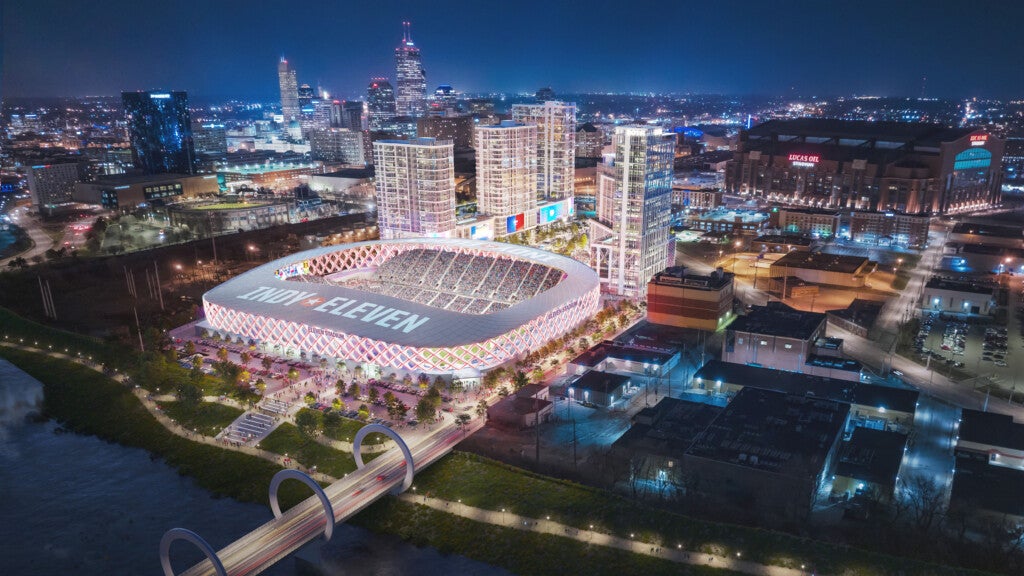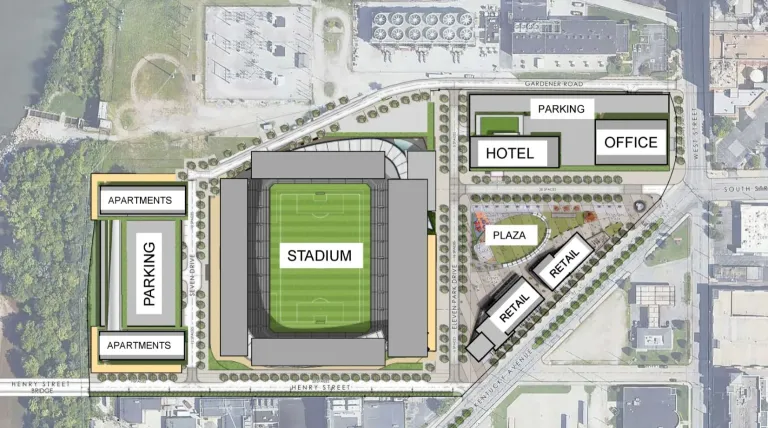Human remains found at Indy Eleven construction site
INDIANAPOLIS (WISH) — Human remains were discovered at the Indy Eleven construction site while crews were demolishing the former building and starting to prepare the site for the new development.
This plot of land between Kentucky Avenue and the White River was once Greenlawn Cemetery. The history dates back to the 17th century.
Human remains were found in the northern portion of the land.
Leon Bates, an Indianapolis historian who is doctorate candidate, said the area was where early Indiana settlers and U.S. Civil War Union soldiers were buried.
“This is not a surprise at all to any of us,” Bates said. “It was a little bit of a surprise they found them so early. We thought it would be a little bit longer before they actually got in the ground and found any remains.”
The story originally gained attention when advocates noted the oldest part of the cemetery could contain the remains of up to 2,000 African American people who had never been moved over the years.
“The African Americans, the majority of them, we believe were buried in the old ‘bury grounds’ next to the river,” Bates said. “There were hundreds, if not thousands of African Americans buried back there and there’s no record, we can find, that they were moved. So, we do not know where they are but we highly suspect they were left behind.”
Bates believes crews will find more remains as they work closer to the White River where he and others believe many African Americans continue to be buried.
Bates said Greenlawn Cemetery was four separate cemeteries at one point, and the old ‘bury grounds’ section was the first public cemetery in the city. He said many African Americans were buried there because there was no cost and it was an option they could afford.
A map from the U.S. Library of Congress shows the cemetery broken into three sections and does not differentiate between the north “bury ground” and the new “bury ground,” which Bates said takes up the section that runs along Kentucky Avenue on the map.
The Indiana Department of Natural Resources said its Division of Historic Preservation and Archeology oversees the work and reviews development plans that are within 100 feet of a cemetery. Indiana law requires developers to get an archeological plan approved if human remains are found. In November, Keystone Group told News 8 it already had an archeological plan in place.
In an email to News 8, a Natural Resources (DNR) representative shared the requirements for an archeological plan.
“Under IC (Indiana Code)-14-21-1-26.5, the DNR Division of Historic Preservation and Archeology (DHPA) reviews plans for developments that are within 100 feet of a cemetery. If human remains are found during any ground disturbance in Indiana, the law (IC 14-21-1-29) requires that digging must pause and that an archeological plan be approved before digging can continue. These plans must include a recovery plan for how human remains will be treated if they are discovered during construction; detail how an archeologist will monitor areas with a high probability for burials; detail the field methods for recovery of remains, laboratory processing and analysis, and reporting; and detail commitments for reinterment of remains at another local cemetery.
(For this project, DNR requested an archeological plan from the developer. Both the cemetery development plan and archaeological monitoring plan have been approved by the DNR. This plan is currently being followed with remains now being recovered and reinterned.”
Indiana Department of Natural Resources
Bates said, while the law does not require developers to do a preemptive search, he believes that would have been the best option. “Building on top of a cemetery or building on top of a graveyard, there’s just something wrong with that idea. And if you’re going to build, if you’re going to do it, move the people out. Their plan is not to move people. It’s to only move those they find. If they don’t find them, they’re going to build on top of them.”
Keystone Group shared a statement with News 8 regarding the discovery of human remains.
“Keystone Group in coordination with Weintraut and Associates and the Indiana Department of Natural Resources/Division of Historic Preservation and Archaeology (IDNR/DHPA) have identified isolated areas of interest at the former site of Diamond Chain. Weintraut and Associates along with the IDNR/DHPA are conducting a thorough and respectful analysis on the discovery of materials and determined the following:
“Fragments of human remains have been identified at the north end of the site. The discoveries are all undergoing and adhering to strict identification protocols. The discoveries will be properly catalogued and subsequently reinterned at the discretion of the IDNR/DHPA and Keystone. As construction continues at the site, Keystone, Weintraut and Associates, and the IDNR/DHPA will continue to follow the lawful guidelines at both the state and local level with the utmost sensitivity.
“Keystone views these discoveries as an opportunity to correct past mishandlings by previous ownership and to respectfully relocate and honor what may be found. Keystone continues to work with community organizations who look to honor the memory of those who may have been buried at Greenlawn. These discussions are ongoing as the project progresses and an appropriate memorial will be included in project completion.”
Keystone Group
Related coverage
- Advocates concerned site of Indy soccer stadium could have human remains
- Gov. Holcomb, Indy Eleven break ground on Eleven Park
- WISH-TV on YouTube: Indy Eleven stadium designs unveiled

